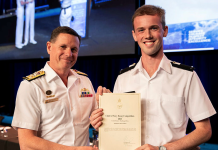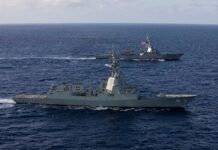By Anthony Milner*
In October 2016, before the US presidential election, I suggested that Australia was entering a foreign-policy crisis period—given the relative decline of American power in the Asian region, the likely withdrawal of the US from the Trans-Pacific Partnership, and the possibility of a Donald Trump presidency. We’ve had these crises before, especially in the late 1940s, before the US alliance replaced the British Empire as our protective umbrella. After seven decades of that alliance, it was clear that we needed to work creatively on a Plan B, and I thought that some Turnbull government initiatives on Singapore, Indonesia and the Philippines were signs of new thinking.
My focus was on diplomatic and political strategy. Over the past year, the prime minister’s ASEAN summit in March helped position Australia in the region, and we continue to cooperate with South Korea in ASEAN-led organisations and the MIKTA partnership (which includes Indonesia).
Security cooperation with our long-term economic partner Japan develops incrementally, with talk early this year of a reciprocal access agreement. In the case of India, Peter Varghese—former DFAT secretary—has just completed a massive report on how to foster closer security and economic bonds. The signing of the TPP—without the US, but including Japan, Malaysia, Singapore and Vietnam—appears shrewd, as does our caution about confronting China in the South China Sea. The continued wooing of President Trump may be less productive in regional terms.
As the Trump administration has become increasingly unreliable and bizarre, discussion of a Plan B is concentrating more sharply on defence capacity. Strategic analyst Paul Dibb says we must ‘focus more on our region of primary strategic concern’, and also need to increase our defence expenditure. But he still believes that America won’t ‘pull out of Asia’ and says that Australia needs to ensure that it ‘continue[s] to have access to highly advanced American military equipment’ to ‘maintain our technological edge in our region’. Insisting that Australia has ‘no credible defence without the US alliance’, Dibb continues largely to think within the old paradigm.
ASPI chief Peter Jennings has been formulating a genuine Plan B. Although hoping Australia will do everything to ‘sustain the alliance’, he believes little thought has been given to ‘the worst-case scenario’. Jennings argues that we must ‘do more for our own security’, positioning ourselves to operate ‘without confidence in the US security umbrella’. To that end, Australia must lift its defence spending to 2.5% or 3% of GDP, develop nuclear-powered submarines, and strengthen its defence relationships with Japan, Indonesia and India.
It’s hard to believe that that level of military enhancement will equip Australia to operate separately from the US. Going back to an earlier crisis time in our foreign relations, the late 1960s (when once again the level of US commitment to the Asian region was in doubt), the Gorton government was reluctant to sign the Nuclear Non-Proliferation Treaty, and gave serious thought to developing an Australian nuclear weapon. John Gorton’s Liberal successor, William McMahon, returned to reliance on the US as the primary national security strategy. But another senior Liberal, Malcolm Fraser, also wanted a more ‘independent Australian foreign policy’, and to him (as reported in his memoirs) that meant ‘greater and more intense alliances within the region’.
The Gorton nuclear position, it must be said, has at least a degree of logical integrity. It is genuinely muscular, but would require sophisticated and courageous advocacy in Australia and our neighbourhood.
As to the Jennings (and Fraser) emphasis on developing greater defence engagement in Asia, it has promise—but it’s a complex task, and one that must be enmeshed with broader political and economic diplomacy. There’s a general wariness in the region about alliances. Allying against China is dangerous for us, not only because Australia (by any international standards) is economically bound to China, but also because many other countries in the region want to avoid Cold War–style confrontation. That’s certainly the case in most of Southeast Asia, as was made clear at the Australia–ASEAN meetings in Sydney this year.
Leaders on both sides of Australian politics have expressed support for some form of quadrilateral (US, Japan, India, Australia) security cooperation. At times, each of these countries has signalled an interest, but we would be unwise at this stage to assume serious commitment on any of their parts.
Euan Graham has suggested that Australia and Japan are ‘more united in mutual caution than shared strategic ambition’. Japan, of course, is anxious about China, but the emergence since 2008 of the three-cornered (China, Japan, South Korea) Trilateral Northeast Asia Summit is an indication of a new commitment to reconciliation. India too has its serious China issues, but in 2017 became a full member of China’s Shanghai Cooperation Organization—and this year again kept Australia out of its Malabar naval exercises with the US.
The strategic context in the Asian region today is fluid, and Australians tend to prefer black-and-white clarity. But if we reject a Gorton ‘Fortress Australia’ option, our Plan B must stress diplomacy—and must recognise that deeper engagement with Asia will require much patience. We’ll need to look beyond our immediate security or economic gains, and that is always difficult for short-term democratic governments.
Building Australia’s independent influence in Asia must be a long game—moving between the different nations in the region, large and small, and sometimes leveraging relations with one state to advance engagement with another. Well-publicised successes with ASEAN countries (particularly Indonesia) always enhance our reputation and strengthen our voice with major powers.
Promoting the ideal of a rules-based order—as we have been—is a potentially productive measure, but the focus should be on working with Asian partners to gain a consensus understanding of ‘the rules’. We have a long track record in international rule-making, particularly in the founding period of the United Nations. At that time, as Paul Hasluck explained long ago (‘Australia and the formation of the United Nations’, Royal Australian Historical Society, vol. XL, no. III, 1954, pp. 133–78), we played the role of broker between major and smaller states. And we could gain respect today by becoming a broker in a civilisational context.
Working creatively with our region—in almost any way—is what matters. To avoid becoming a ‘lonely nation’ in a possible post-American Asia ought to be a high priority, unless we wish to choose and fund a Fortress Australia.
* Anthony Milner is international director of Asialink and formerly dean of Asian studies at the Australian National University.
First published by the Australian Strategic Policy Institute



